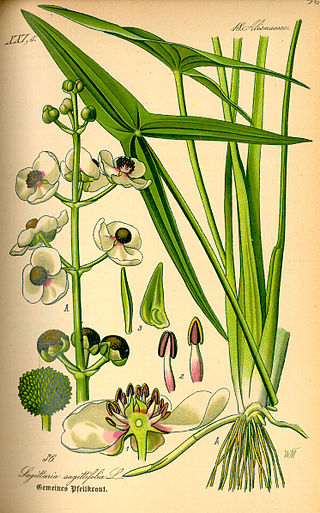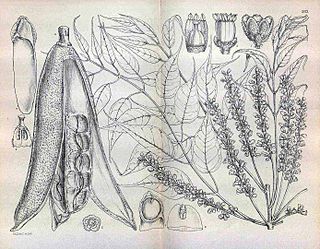
Luzula is a genus of flowering plants in the rush family Juncaceae. The genus has a cosmopolitan distribution, with species occurring throughout the world, especially in temperate regions, the Arctic, and higher elevation areas in the tropics. Plants of the genus are known commonly as wood-rush, wood rush, or woodrush. Possible origins of the genus name include the Italian lucciola or the Latin luzulae or luxulae, from lux ("light"), inspired by the way the plants sparkle when wet with dew. Another etymology sometimes given is that it does derive from lucciola but that this meant a mid-summer field, or from the Latin luculus, meaning a small place; the same source also states that this name was applied by Luigi Anguillara in 1561.

Sagittaria is a genus of about 30 species of aquatic plants whose members go by a variety of common names, including arrowhead, duck potato, katniss, swamp potato, tule potato, wapato or wapatoo, and omodaka. Most are native to South, Central, and North America, but there are also some from Europe, Africa, and Asia.

Ehrharta is a genus of plants in the grass family.

Echinodorus, commonly known as burhead or Amazon sword, is a genus of plants in the family Alismataceae, native to the Western Hemisphere from the central United States to Argentina. Its scientific name is derived from Ancient Greek echius – "rough husk" - and doros – "leathern bottle" - alluding to ovaries, which in some species are armed with persistent styles, forming prickly head of fruit. Some of the species are commonly cultivated in artificial aquatic habitats.

Nepenthes vieillardii is a species of pitcher plant endemic to the island of New Caledonia. Its distribution is the most easterly of any Nepenthes species. Its natural habitat is shrublands or forests, to about 900 metres (3,000 ft) altitude.

Themeda triandra is a species of C4 perennial tussock-forming grass widespread in Africa, Australia, Asia and the Pacific. In Australia it is commonly known as kangaroo grass and in East Africa and South Africa it is known as red grass and red oat grass or as rooigras in Afrikaans. Kangaroo grass was formerly thought to be one of two species, and was named Themeda australis.

Areca triandra, the wild areca palm, is a palm which is often used as ornamental plant. It is native to India, Bangladesh, Cambodia, Laos, Burma, Thailand, Vietnam, Malaysia, Indonesia, and the Philippines. It is also reportedly naturalized in Panama and in southern China. As a wild plant, it commonly occurs in littoral forest in Southeast Asia.
Wallichia triandra is a species of flowering plant in the family Arecaceae that is native to South Tibet in China and also to the neighboring Arunachal Pradesh region of India.

Horsfieldia is a genus of evergreen trees. The genus consists of about 100 species and is distributed across South Asia, from India to the Philippines and Papua New Guinea. Some species are used for timber. Species in the genus sometimes contain alkaloids, including horsfiline, which has analgesic effects.

Salix triandra, with the common names almond willow, almond-leaved willow or black maul willow, is a species of willow native to Europe and Western and Central Asia. It is found from south-eastern England east to Lake Baikal, and south to Spain and the Mediterranean east to the Caucasus, and the Alborz Mountains. It usually grows in riparian habitats, on river and stream banks, and in wetlands.

Themeda is a genus of plants in the grass family native to Asia, Africa, Australia, and Papuasia. There are about 18 to 26 species, many of which are native to Southeast Asia.

Leersia is a genus of plants in the grass family which includes species known generally as cutgrasses.
Pseudanthistiria is a genus of Asian plants in the grass family.

Entandrophragma caudatum, or mountain mahogany, is a large Southern African tree belonging to the mahogany family and found in eastern and north eastern South Africa, Eswatini, Botswana, Angola, the Caprivi Strip region of Namibia, Zimbabwe, Zambia and Malawi. Kew currently recognises 12 other species of Entandrophragma, all with a tropical and sub-tropical African distribution.

Tinnea (sunbells) is a genus of plants in the family Lamiaceae first described in 1867. It is native to sub-Saharan Africa. It was named in honour of the Dutch explorer Alexine Tinne.
- Tinnea aethiopicaKotschy ex Hook.f. - widespread from Mali to Somalia south to Mozambique; naturalized in Trinidad & Tobago
- Tinnea antiscorbuticaWelw. - DRC, Zambia, Angola
- Tinnea apiculataRobyns & Lebrun - eastern Africa from Rwanda to Mozambique
- Tinnea barbataVollesen - Eswatini, northern South Africa
- Tinnea barteriGürke - western Africa
- Tinnea benguellensisGürke - Angola
- Tinnea coeruleaGürke - DRC, Zambia, Angola
- Tinnea eriocalyxWelw. - DRC, Angola, Botswana, Namibia
- Tinnea galpiniiBriq. - Eswatini, Mozambique, South Africa
- Tinnea gossweileriRobyns & Lebrun - Angola
- Tinnea gracilisGürke - Tanzania to Zambia
- Tinnea mirabilis(Bullock) Vollesen - Tanzania
- Tinnea physalisE.A.Bruce - Tanzania
- Tinnea platyphyllaBriq. - DRC
- Tinnea rhodesianaS.Moore - South Africa, Namibia, Zimbabwe, Zambia, Angola, Mozambique
- Tinnea somalensisGürke ex Chiov. - Ethiopia
- Tinnea vesiculosaGürke - Tanzania, Malawi
- Tinnea vestitaBaker - Zimbabwe, Zambia, Angola, Botswana
- Tinnea zambesiacaBaker - Zimbabwe, Zambia, Malawi, Mozambique

Cissus cornifolia is a species of flowering plant in the Vitaceae family. It is an erect or semi-scandent woody shrub up to 3 meters in height belonging to the grape family of Vitaceae, and found from sub-Saharan Africa and Tropical Africa south to Botswana, Mozambique and South Africa. It is one of more than 300 species forming the genus Cissus.

Kewa is a genus of flowering plants, consisting of eight species of succulent sub-woody plants, native to eastern and southern Africa, including Saint Helena and Madagascar. These are small shrubs or herbs that form cushions and have edible, acid-tasting leaves. Kewa is the only genus in the family Kewaceae.
Requienia is a genus of flowering plants in the family Fabaceae. It includes two species of herbs native to Botswana, Caprivi Strip, Namibia, and Zambia, and the Cape Provinces, Free State and Northern Provinces of South Africa. They grow on sand in dry tropical wooded grassland, shrubland, and bushland in the southern Zambezian region and the Kalahari and Highveld regions.

Tristerix aphyllus is a holoparasitic plant species of the genus Tristerix in the family Loranthaceae. It is endemic to Chile. T. aphyllus is sometimes called the "cactus mistletoe." It should not be confused with the mistletoe cactus, which is an epiphytic cactus, and not a mistletoe.

Pterodiscus is a genus of plant in the Pedaliaceae family comprising several species with a native range from Ethiopia to S. Africa. The range passes through the countries of Angola, Botswana,, Ethiopia, Kenya, Mozambique, Namibia, Somalia, Sudan, Tanzania, Zambia and Zimbabwe. Plus it is found also within the Provinces of South Africa in Cape Provinces, Free State, KwaZulu-Natal and Northern Provinces.















